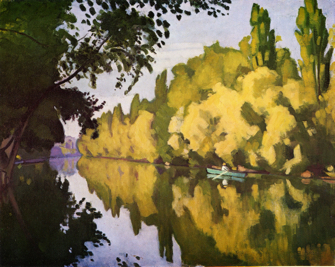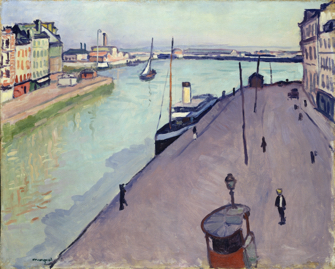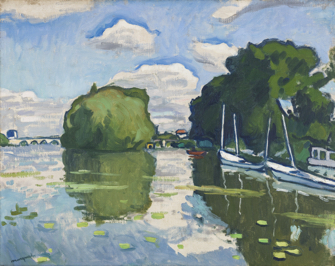If Poussin
Painted Like a Child

“La Varenne Saint-Hilaire, la Barque” (1913). © Richard Nathanson, London/ADAGP, Paris 2016
At first glance, many of the paintings of Albert Marquet (1875-1947) look simple, almost childlike. There is great power in that simplicity, however, and now that I have seen the retrospective “Albert Marquet: Peintre du Temps Suspendu” at the Musée d’Art Moderne de la Ville de Paris, I know that the artist jumped through all the hoops of artistic training before he was able to pare his style down to that extreme simplicity (which never went so far as abstraction, however). As he put it, his goal was to “paint like a child without forgetting Poussin.” The art critic Claude Roger-Marx compared Marquet to Manet, noting that they had “the same simplicity, the same boldness of tone, the same disdain for what people might say.”
Born in Bordeaux in 1875, the young Marquet moved to Paris with his mother as a teenager to study art and was taught by Gustave Moreau in the company of such future luminaries of the art world as Henri Matisse, Henri Manguin and Georges Rouault. Moreau encouraged his students to study the masters while developing their own artistic style. One movement that largely grew out of his studio was Fauvism. Marquet, who was friends with many of the Fauve artists, exhibited with them and dabbled in the style, with its wonderful wild colors. Although the movement was short-lived, it seems to have informed Marquet’s style for life.
The early works in the show confirm that Marquet was perfectly capable of painting in a variety of styles. It’s interesting to compare the

“Nu dit Fauve” (1898). Photo: L. Gauthier, Musée des Beaux-Arts-Mairie de Bordeaux © ADAGP, Paris 2016
styles of two nudes, a charming studio painting in intense contrasting colors, “Nu dit Fauve” (1898), with the polished “Nu au Divan” (1914). Not only are the colors and treatment completely different, but also the mood of each work. In the former, the model stands with her back turned to the artist and her arms folded over her breasts. In the latter, the model sits facing the viewer, staring directly at the painter with sultry, narrowed eyes, her arms folded behind her head, boldly exposing her body, with one leg teasingly crossed over the other. The exhibition, by the way, includes a series of erotic works by Marquet.
After a room full of his drawings – delightfully simple, lively and expressive – the exhibition quickly moves on to the artist’s favorite subject: landscapes, especially seascapes. Like many of the artists of his time, Marquet was fascinated by Japanese prints, and their influence can be seen many of these works with their flat expanses of color and simplified forms. Matisse even called him “our Hokusai.”
Around the turn of the century, Marquet worked out the spatial organization for his landscapes. Each contained a cubic shape, which might be a house or church, and

“Vue du Port du Havre (Le Quai de Notre Dame)” (c. 1911) © ADAGP, Paris 2016/Fondation Collection E.G. Bührle, Zurich/ISEA
a vertical, diagonal and horizontal element. Admittedly, the use of this schema for the rest of his life (with, of course, some exceptions) made for a certain sameness in his works, but it also lends his paintings a certain calm, restful aura. And, since Marquet was something of a genius with color and capturing light, especially seaside light, they are full of good cheer. Without knowing anything

“La Seine à Poissy” (1908). © ADAGP, Paris, 2016/Musée d’Art Moderne/Roger-Viollet
about the personal life of the artist, one would imagine him to be a happy man (he seems to have been, with his many good friends and travels and a successful professional life), and looking at his paintings makes the viewer feel happy, too. Although Marquet was not the most revolutionary painter of his time, I still recommend seeing this exhibition for a good spot of art therapy.
Musée d’Art Moderne de la Ville de Paris: 11, avenue du Président Wilson, 75016 Paris. Métro: Alma-Marceau or Iéna. Tel.: 01 53 67 40 00. Open Tuesday-Sunday, 10 a.m.-6 p.m. (Thursday until 10 p.m.). Closed on public holidays. Admission: €12. Through August 21, 2016. www.mam.paris.fr
Reader reaction: Click here to respond to this article (your response may be published on this page and is subject to editing).
More reviews of Paris art shows.
© 2016 Paris Update
Favorite